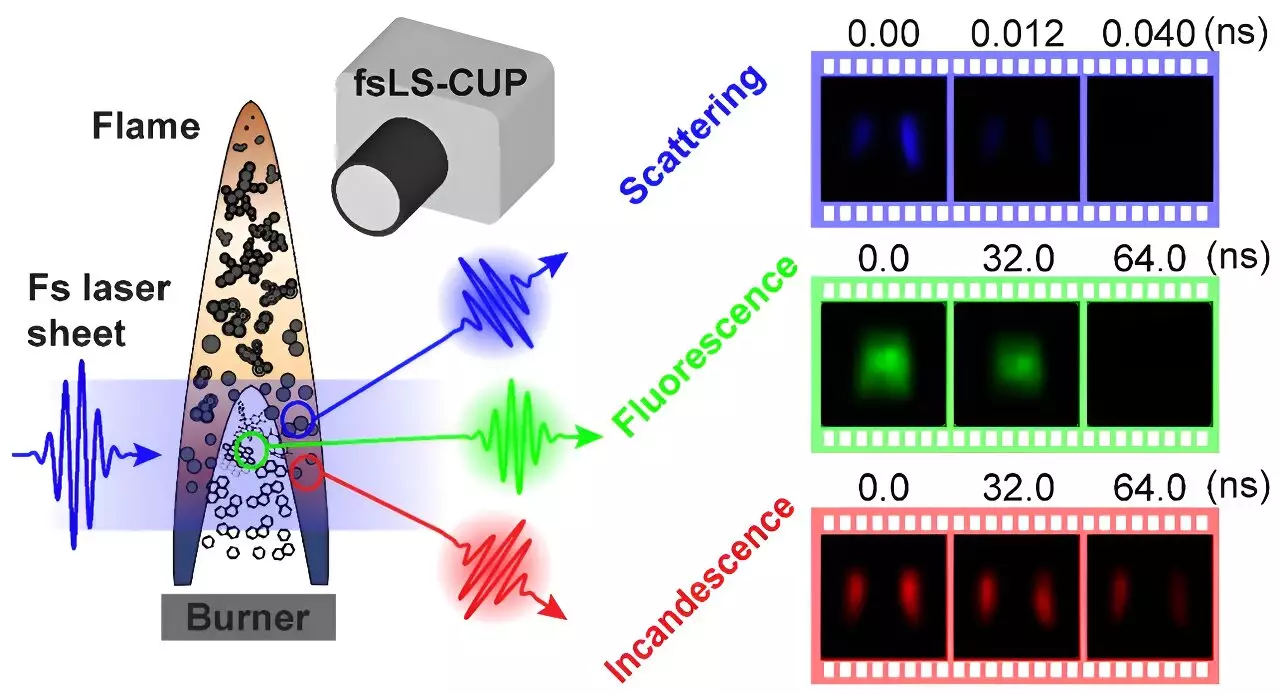The intricate processes associated with combustion, such as the formation of soot and polycyclic aromatic hydrocarbons (PAHs), have drawn considerable scientific interest due to their implications for both environmental health and technological advancements. Soot and PAHs are not merely byproducts of burning materials; they represent significant challenges for human health and ecological balance. Although these carbon-based particles are prevalent in various natural and man-made environments—including as constituents of interstellar matter—they are also valuable for innovative applications in fields such as electronics and renewable energy. To understand these phenomena effectively, researchers require cutting-edge imaging technology capable of capturing the extremely fast dynamics involved in these reactions.
Capturing the intricate behavior of soot and PAHs in flames presents numerous challenges. The signals produced by these substances are ephemeral, often disappearing within fractions of a second. Traditional imaging systems can only manage to record a few million frames per second and typically depend on multiple successive laser pulses. This multi-pulse requirement can result in additional heating, complicating the results and potentially affecting the phenomena being observed. Moreover, these systems rely on sequential imaging rather than real-time capturing, limiting the breadth of information that can be gathered about these transient events.
Faced with these limitations, scientists in combustion research have long anticipated a revolutionary technique that could provide accurate, high-speed imaging capabilities. The publication of a pioneering method called femtosecond laser sheet-compressed ultrafast photography (fsLS-CUP) marks a significant turning point in this quest.
Developed by a collaborative team including Dr. Yogeshwar Nath Mishra and Professor Lihong V. Wang from the California Institute of Technology, alongside Dr. Florian J. Bauer from Friedrich-Alexander University Erlangen, fsLS-CUP represents a significant advancement in ultrafast imaging science. This innovative technique enables researchers to capture entire sequences of femtosecond laser-flame dynamics at an astounding rate of 250 billion frames per second (Gfps)—a staggering leap that is 20,000 times faster than what current imaging systems can offer.
A groundbreaking aspect of fsLS-CUP is that it employs only a single femtosecond laser pulse to achieve its results. This capability allows for simultaneous imaging of multiple phenomena, including laser-induced fluorescence from PAHs and thermal dynamics from soot particles. The technique also captures elastic light scattering interactions between the laser and soot, providing a comprehensive view of the combustion process.
The implications of this advanced imaging technology extend well beyond combustion science. Dr. Peng Wang highlighted the far-reaching potential of fsLS-CUP to unlock rapid phenomena crucial to natural sciences and technology. This comprehensive imaging approach offers researchers unprecedented insights into hydrocarbon and nanoparticle formation, aiding in our understanding of fundamental processes that span physics, chemistry, medicine, environmental science, and even astrophysics.
The technique holds particular relevance to NASA’s quest to explore origins of life and cosmic evolution. By elucidating the behaviors of PAHs, particularly those formed in extreme environments like carbon-rich asymptotic giant branch stars, scientists can broaden their understanding of molecular robustness in the cosmos.
As the researchers continue to refine and expand upon fsLS-CUP, the emphasis on collaboration and innovation is paramount. Future developments aim to further enhance speed, spatial resolution, and image fidelity. Dr. Florian Bauer reaffirmed that the method’s foundational principle of single-shot data acquisition via compressed sensing allows for a versatile and adaptable approach toward real-time observation of femtosecond laser-induced signals in various contexts.
The successful extraction of detailed data, including the distribution of fluorescence lifetimes of PAH molecules, indicates a promising horizon for research into the intricacies of combustion and molecular interactions. The confirmed capability of femtosecond laser pulses to induce incandescence in soot particles serves as a testament to the power and precision of this innovative imaging technique.
The advent of fsLS-CUP stands as a landmark achievement in ultrafast imaging technology, opening up new avenues for research into transient phenomena that characterize complex reactions in combustion. As scientists harness the capabilities of this revolutionary method, a deeper understanding of soot and PAH formation will not only contribute to advancements in environmental and combustion science but also resonate across a spectrum of scientific disciplines, paving the way for future discoveries in both terrestrial and extraterrestrial realms.


Leave a Reply